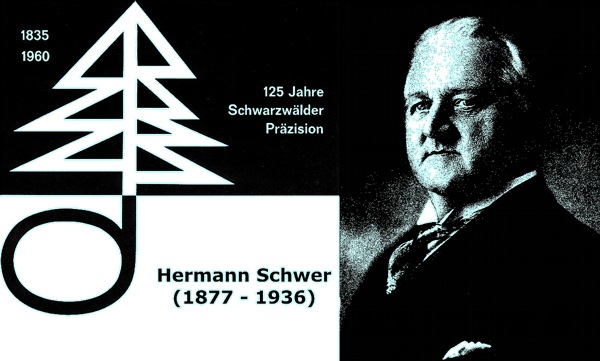|
Beautiful DeLuxe German Saba Radio 1959 Model 300-10T, Meersburg Automatic 100 Export Model, with Motor Tuning, 9 Tubes, 4 Speakers, FM AM SW and LW Bands, Phono and Tape Input, Serviced and Working
In a Nutshell
With a 1950's SABA your eyes and ears simply get much more radio than with any other 1950's radio - that's why they are so collectible

Introduction:
The history of SABA is excellently documented in ref.1 and 2 below, both articles being written in German. The first article is written by Ernst Erb, the prime mover behind radiomuseum.org, and is easier to read than its English translation in ref.3. What else can you produce in Triberg, located in Schwarzwald country (Black Forest) in South-Western Germany? Clocks of course - and that's what Joseph Benedikt Schwer started doing in 1835. His grandson Hermann, a skilled watchmaker himself, took over in 1905, moved the factory to nearby Villingen, and started building radio parts and kits in 1923 and whole radio sets in 1927 under the name of SABA (standing for Schwarzwälder Apparate-Bau-Anstalt August Schwer Söhne). In 1935 export oriented Saba was already represented in 13 countries. In the 1950's, shortly after UKW (Ultrakurzwelle = FM) but before transistors and stereophony (not available until 1963) came up, a large number of big German tube table radios flooded the market from manufacturers like AEG, Blaupunkt, Graetz, Grundig, Koerting, Loewe Opta, Nordmende, Saba, Schaub-Lorenz, Siemens and others. The phenomenon was part of the "Deutsches Wirtschaftswunder" (economic miracle), a period of post-war prosperity under chancellor Konrad Adenauer and his minister of economics Ludwig Ehrhard (born in Grundig town of Fürth in Bavaria). Some of the finest and most collectible radios are Saba sets, some of which come with a cable remote, that not only allows remote control of on/off and volume, like others but also remote station tuning. This is achieved with Sabas famous automatic station scanning and automatic frequency control, a feature accomplished by a 2-tube device ("Steuerfilter") automatically detecting and amplifying deviations from optimal reception to steer a motor, which itself is connected to the tuning capacitors and manual tuning knob through a clutch, that switches between AM and FM (see my movies at the end of the picture gallery). Model names for these radios are taken from Black Forest and South-West Germany regions and towns like Breisgau, Württemberg, Schauinsland, Triberg, Villingen, Freiburg, Freudenstadt, Lindau, Wildbad, Meersburg, Konstanz, and others. Export versions just have prosaic numbers as model identifications. Saba radios are best documented, having an own private forum (ref.4), that helped me appreciably restoring the radio offered here (see techies below). The original price tag was a hefty 549 DM (today US$~2000).
For the techies only:
There are three reasons I started restoring this radio:
a. its perfect and mint exterior condition
b. my interest to study Sabas Automatic Tuning and Frequency Control technology
c. I witnessed the "Wunder von Bern" (miracle of Berne) on a Saba on July 4th, 1954, when Germany won the soccer world cup against Hungary
The problem of this radio was degradation of pot metal by zinc disease (ref.5), or - in German - by the "Zinkpest, Zinkfrass oder Zinkbeißer". Three parts in this radio are made from pot metal (see pict.s 35-38), the coupler ("Kupplung") to the volume knob, and two quarter shells and the entrainer ("Mitnehmer") of the automatic clutch. The former was easy to replace by a piece made from plastic, the entrainer was in perfect shape without any signs of zinc rot, but the two quarter shells came in pieces and were not allowing the radio to be tuned on any band or any mode, manually or automatic. I made replacement shells by hand from aluminum, where tolerances of the order of one tenth of a millimeter were required (pict.s 36-38). I replaced all 21 of the infamous black Saba capacitors (pict.s 29,30), the selenium rectifier by a Si bridge rectifier, as is often done even preventively (pict.s 39,40), four more selenium diodes and one weak EC92 by a NOS 6C4 (internally connected pin 5 cut). The line voltage was set to 110 Volt, and a dropping resistor of 40Ω added to compensate for the smaller Si bias. The motor and dialcord cogs were painstakingly cleaned and oiled, to achieve smooth-running of the motor tuning. Finally the whole set was aligned on all bands by following the 2-page "Abgleichanleitung" of the manual. In particular the alignment of the "Steuerfilter" profited from the use of a signal generator (Hickok 288X) and an oscilloscope (see movies by clicking on thumbnails 46-48).
Finally I should comment on the "Stereo" and "Mono" pushbuttons: Stereo reception was not available in Germany until 1963. The push-buttons allow stereo amplifiers, tape and phono inputs to be routed to the internal speaker (mono) or to the internal and external speakers (stereo).
Additional information:
ref. 1. http://www.radiomuseum.org/dsp_hersteller_detail.cfm?company_id=22
ref. 2. http://www.saba.pytalhost.com/Werbung/100jahrefestschrift/index.html
ref. 3. http://www.economypoint.org/s/saba.html
ref. 4. http://saba.magnetofon.de/showtopic.php?threadid=3861
ref. 5. http://en.wikipedia.org/wiki/Pot_metal
About my radio:
The time consuming restoration paid off: here is a beautiful 1959 Saba Meersburg Automatic 100 in near to new condition with all critical and failure-prone parts having been taken care of. Its export version 300-10T sold here differs from the original in two points: the FM scale extends to 108 MHz (instead of 100 MHz), and the conversion from 50 to 60 Hz line frequency (change of two capacitors of the "Steuerfilter") is already built in. The radio plays loud and clear and with superb sensitivity and selectivity on all bands - yes, also on short wave. It finds stations with the tip of a finger and holds tight on them, as testified by the bright green bar of the tuning eye. Please e-mail me (Kris) for any questions, ich spreche Deutsch, je parle Français.
Here are the specifications:
| Technical Description of Item |
| Manufacturer |
Schwarzwälder Apparate-Bau-Anstalt (SABA) , Villingen, Germany |
| Model |
300-10T = Export version of Meersburg Automatic 100 |
| Type |
9-tube LW, MW, SW, FM Superheterodyne radio receiver |
| Features |
SABA Automatic motor tuning, phono and tape inputs, poss. for stereo amp. |
| Production Year |
1959/60 |
| Serial Number |
506671 |
| Cabinet |
Mahogany and maple wood, golden metal |
| Dial |
Illuminated reverse painted glass |
| Knobs |
2(3) original bakelite knobs with brass fittings |
| Frequency Range |
LW 140-360 kHz, AM 510-1640 kHz, SW 5.9-18.9 MHz, FM 87-108 MHz |
| Controls |
Volume, antenna, tuning, tone ctrls, push-button band selector |
| Tube line-up |
EM84, 2xEC92 (one 6C4), ECH81, EF85, 2xEABC80, EL84, ECL80 |
| Size (WxDxH) |
25" x 11½" x 16" |
| Weight |
36 lbs = 16.3 kg |
| Comment |
Excellent condition, serviced and perfectly working |
|




